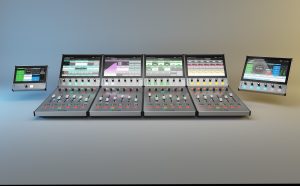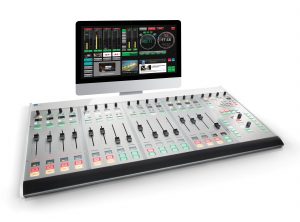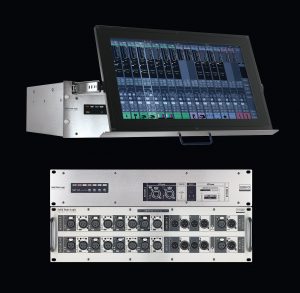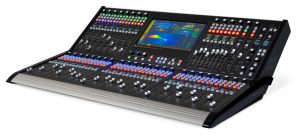Tech Focus: Sports Radio, Part 3 — Audio Consoles Keep Pace With Tech Advances
AoIP, flexibility, customization are major features
Story Highlights
Sports broadcasts on the radio have their own special requirements, and manufacturers have kept their broadcast audio consoles up to date. Here are a few of the leading flagship models.
Click here for Tech Focus: Sports Radio, Part 1 — ESPN Readies New Radio, Podcasting Facility
Click here for Tech Focus: Sports Radio, Part 2 — The Future Is Streaming, Multichannel
The Calrec Type R modular, expandable, IP-based audio console features standard networking technology, combining it with configurable soft panels that can be tailored to operator needs. Type R’s physical control system comprises three slimline panels: a fader panel and a large and a small soft panel. Each is compatible with COTS hardware and powered over Ethernet to keep cabling to a minimum. Type R has a simple 2RU core with integrated I/O resources to get customers up and running immediately. A single core can power as many as three independent mixing environments with dedicated DSP resources. Whether it is used as an independent studio console or microphone processor or for utility mixing, the ability to use multiple mixing engines combined with the flexibility of an AES67-compatible network provides enough flexibility to keep pace with changing requirements. Type R provides simple customization across established networks, open control protocols, and surface personalization. With a native-IP backbone, it provides an infrastructure for future expansion.
Lawo’s Ruby Radio Mixing Console delivers true AES67 networking with RAVENNA, a customizable, context-sensitive touchscreen GUI, AutoMix smart mixing, and a 1RU Power Core mixing engine with hundreds of standard AoIP and MADI connections plus eight expansion slots for analog, AES3, Dante, and studio-I/O connections. Reliability is ensured by dual-redundant networking with SMPTE 2022-7 Seamless Protection Switching and ST 2110-30 for seamless interoperability within combined radio/TV broadcast plants. Other features include 1,920×1,920 routing matrix, 96 channels of DSP, and four-, eight-, 12-, and 16-fader frame sizes for consoles as large as 60 faders.
Consisting of IO, processing, and control software and hardware distributed across network devices and computers, SSL’s System T and Network IO broadcast platform provides flexibility, scalability, and interoperability for radio and streaming. Direct-from-console AoIP routing control of Dante, AES67, and ST 2110-30 provides an unlimited audio matrix, connection management, and audio shuffling for true AoIP interoperability. Any AoIP input or output is immediately accessible to the console operator. System T’s programmable Events software provides customized macros and controls for simplified operation and integration. Eight built-in independent AutoMix groups complement full processing on all channels and buses. A comprehensive onboard Effects rack includes processing, metering, and measurement tools. Multiple remote-control positions on LAN or VPN provide independent controls for collaborative remote or decentralized working.
The Studer Glacier Series is a highly customizable broadcast-audio solution that provides two streamlined modules to make operation faster and easier by providing essential controls for live broadcast. The multi-touch graphical user interface provides a virtualized control surface that allows users to customize controls to suit their needs, host comprehensive control interfaces for additional equipment, and simplify the studio environment. Multiple modules can be added to create custom-tailored consoles that bring new levels of control and versatility to any broadcast. The Studer Glacier GUI can be personalized to match the technical requirements of each user, displaying needed controls and hiding unnecessary ones. This streamlines operation and reduces visual distraction during time-sensitive situations. Features include modular, IP-based scalable architecture, with PoE (Power over Ethernet) connection to modules; Studer FaderGlow for quick function and channel identification; a Central Screen Module for quick control; and Fader Module for on-air multitasking.
The Strata 32 is Wheatstone’s newest IP audio console. It packs the latest IP audio innovation into a 40-in. frame, fitting most sports-broadcast scenarios, whether from a MADI-equipped stadium, a remote truck, or a main studio. The console has dedicated faders for eight subgroups and two masters, along with 32 physical faders that can be layered for 64 channels. I/O is managed through separate rack units so that any channel can connect to any audio source, using any preferred audio format at any time, whether it’s HD/SDI, AES, MADI, AoIP, analog, or TDM. Everything essential to audio routing, logic, and processing is situated in racks and accessible via the WheatNet-IP audio network.
Blade 4, the fourth generation of its I/O BLADE, the interface for the company’s WheatNet-IP AoIP protocol, has two OPUS codec channels built in, eliminating the need for an additional codec box to transport audio facility-facility or venue-studio. Blade 4 has provisions for mix-minuses, talkbacks, and other attributes so that, no matter where a particular source is pulled up, talent gets appropriate talkback. It also supports interoperability standards, such as NMOS for discovery and AES67 for audio transport, and provides multichannel support for one, two, or eight channels





